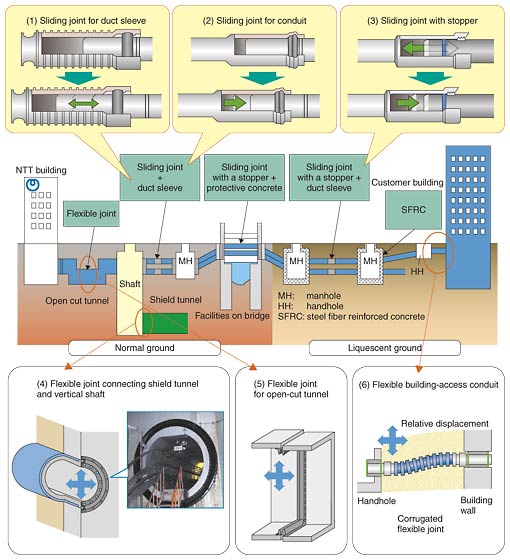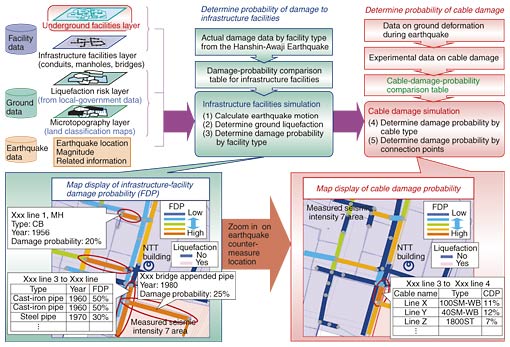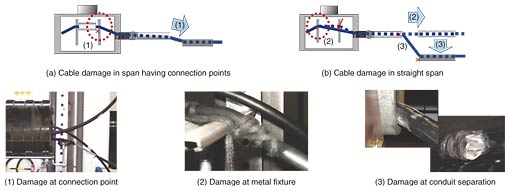 |
|||||
|
|
|||||
|
Letters Vol. 6, No. 1, pp. 58–64, Jan. 2008. https://doi.org/10.53829/ntr200801le1 Seismic Evaluation Technology for Underground Communications FacilitiesAbstractSeismic countermeasures for extensive underground facilities must be efficiently implemented by performing damage simulations under large-scale-earthquake conditions and assigning priority to facility upgrades, starting with the most vulnerable locations. This article describes a seismic evaluation function for underground cables that has been added to a previously developed seismic evaluation system for infrastructure facilities. The addition of this function should improve reliability by enabling seismic evaluation at the communications-service level.
1. IntroductionThe NTT Group takes various measures in preparation for unexpected, large-scale disasters under the basic policies of enhancing the reliability of communication networks, ensuring vital communications, and restoring services early. The Great Hanshin-Awaji Earthquake (Kobe Earthquake) of 1995 and the more recent occurrences of epicentral earthquakes such as the Noto Hanto Earthquake and Niigata Chuetsu Earthquake have underscored the looming threat of earthquakes in Japan. In addition, the probability of an epicentral metropolitan earthquake occurring within the next 30 years has been predicted to be 70%, with that of a Tokai earthquake being over 80%. There is also the possibility that a series of large-scale ocean-trench earthquakes will occur, raising the fear of widespread damage. Against this background, seismic countermeasures that consider the weaknesses of facilities must be investigated on a regular basis and high-reliability facilities must be constructed. Recognizing the importance of high reliability in broadband and ubiquitous services of the future, NTT Access Network Service Systems Laboratories is developing earthquake-oriented reliability evaluation techniques and technologies for developing highly earthquake-resistant facilities. 2. Current state of NTT earthquake-proofing technologiesNTT seismic countermeasures for underground facilities have resulted in improved and newly developed facilities based on the analysis of past facility damage caused by major earthquakes. Since the 1964 Niigata Earthquake, importance has been placed on seismic countermeasures in relation to soil liquefaction and improvements have been made to conduit joints and other components. The effectiveness of these improvements (Fig. 1 (1)–(3)) has already been demonstrated in subsequent major earthquakes.
Furthermore, on the basis of level-2 earthquake motions (equivalent to a seismic intensity of 7 on the Japanese scale) defined by the Japan Society of Civil Engineers (JSCE) following the Great Hanshin-Awaji Earthquake, NTT has been evaluating the earthquake resistance of underground infrastructure facilities based on new standards and implementing appropriate countermeasures (Fig. 1 (4)–(6)). However, such earthquake-resistant facilities were used only when new facilities were installed and have not been applied to the upgrading of facilities constructed under previous specifications and targeted for anti-earthquake reinforcement. Therefore, it was felt necessary to develop a seismic-performance evaluation application. 3. Overview of seismic-performance evaluation applicationThe aging and weakening of underground facilities deployed extensively during Japan's economic boom is expected to escalate. This situation calls for efficient facility upgrading and strengthening. At the same time, it is important to evaluate the seismic performance of extensive infrastructure facilities in order to implement effective seismic countermeasures under a limited budget. As a tool for this purpose, a seismic-performance evaluation application was developed by NTT. It cuts down on the labor required to enter initial data by making use of existing facility and map databases. It was developed and operated as an additional application to Marios, a planning system for infrastructure facilities. The application process begins by calculating seismic intensity and determining liquefaction for each fixed-wiring section using ground data (such as land classification maps (issued by the Geographical Survey Institute) and earthquake data (magnitude, earthquake location, depth, etc.)). This data is updated as needed using seismic and liquefaction data released by local governments and other government bodies. These various types of earthquake-related data are combined with Marios facility data (facility type, year of deployment, etc.) to estimate the damage probability of individual facilities. The estimation of damage probability for infrastructure facilities (conduits, manholes, and bridges) is based on a comparison table created from the relationship between seismic intensity and data on facilities damaged in the Great Hanshin-Awaji Earthquake. 4. Problem with the existing seismic-performance evaluation applicationSubsidence in sections that cross abruptly changing strata or other buried objects can cause shear forces to be applied locally to conduits, resulting in breakage and separation. This, in turn, can apply lateral pressure and shear forces to cables within the conduits, and such cable damage has been reported. In the Niigata Chuetsu Earthquake of 2005, there were reports of transmission loss due to tensile forces applied to entire cables as well as cables cut by metal manhole fixtures as roads in embankment sections collapsed. The addition of a function that could determine the amount of damage that cables in conduits might incur was therefore needed. 5. New cable-damage estimation applicationThe newly developed seismic-performance evaluation application is shown in Fig. 2. The probability of cable damage is estimated from a cable-damage-probability comparison table that combines a table listing ground-displacement probabilities at the time of an earthquake (described later) and a cable-damage-region table determined from experiments. The process through which an underground cable suffers damage in an earthquake is shown in Fig. 3.
(1) When an earthquake occurs, underground facilities shake in unison with the ground. Lateral flow and subsidence occur due to liquefaction. (2) Ground deformation causes conduits to compress, stretch, and bend. Joints break and separate in aging facilities and at locations where the ground deformation is great. (3) Cables in conduits are subjected to tensile, bending, and shear forces, which result in communication faults. 5.1 Quantification of ground deformationWe created a probability table for ground deformation caused by earthquakes, as described in steps (1) and (2). It was prepared by collecting and analyzing data from aerial photographic surveys and longitudinal leveling conducted before and after major earthquakes. The probabilities were presented in terms of seismic intensity and ground liquefaction. 5.2 Cable damage model experimentWe performed an experiment to determine what kinds of external forces might be applied to cables in a conduit and what kinds of mechanisms might be involved in damaging those cables after the conduit itself is damaged by ground deformation, as described in step (3) above. To reproduce actual disaster conditions in this model experiment, we modeled methods for fixing standard conduits, manholes, and cables and examined the extent of cable damage, transmission loss, and fiber strain when conduits were forcibly separated. Typical damage scenarios are introduced below (Fig. 4).
(1) Span with connection points in manhole The cable is pulled through a duct in a manhole, the tension member in a standard closure (steel wire) ruptures, and the cable jacket and fiber are suddenly subjected to tensile forces, which cause a wire break ((a)-(1)). (2) Conduit separation in axial direction Conduit separation causes the cable to be pulled toward the duct in a manhole, producing tension on the entire cable. The cable is pushed onto a metal fixture in the manhole, increasing transmission loss ((b)-(2)). (3) Conduit separation in shear direction An increase in the vertical displacement at the conduit-separation point produces tension across the entire cable and lateral pressure flattens out the cable's cross section. As the cable is pulled out of the damaged section of the conduit, it suffers wear from contact with the conduit edges. This damages the jacket, resulting in transmission loss ((b)-(3)). 6. Facility evaluation exampleWe here present an example of facility evaluation assuming an epicentral metropolitan earthquake using actual facility data and a cable-damage-probability comparison table prepared by quantifying ground deformation and incorporating the results of a cable-damage model experiment. An example of a map display showing the probability of conduit damage is shown in Fig. 5(a). The inner-city district includes many aging facilities because the period of underground-facility construction was some time ago. As a result, there is a high probability of damage overall. In addition, a close look at facilities with a high damage probability reveals that they include a high proportion of cast-iron pipes with socket and spigot joints constructed before 1964.
A map display showing the maximum damage probability for cables in the conduits is shown in Fig. 5(b). Evaluating the damage probability at the level of communication services in this way enables vulnerable locations to be further narrowed down compared with Fig. 5(a). This makes it easier to prioritize the spans that need seismic countermeasures. An operator may also click a cable span on the screen to view detailed cable information that can be used to assign more meaningful priorities by incorporating the importance of that cable. The trigger for upgrading, repairing, or reinforcing infrastructure facilities is based on various types of information in addition to seismic countermeasures. These include information about aging facilities, information about insufficient facility capacity, plans for consolidating multiple routes, plans for joint construction work with other companies, and information about obstacle removal. More effective countermeasures must be taken by performing comprehensive evaluations that combine the above information while taking into account reliability, economy, feasibility, environmental conservation, and other factors with an eye to the future. The red ovals in Fig. 5(b) indicate spans that are characterized by the combination of a cable damage probability above 10% (reliability evaluation), a cast-iron pipe constructed before 1964 (aging evaluation), and a lack of extra space for adding new cables (facility-capacity evaluation). These spans are vulnerable locations of high priority. 7. Addition of other functionsBesides the above underground-cable evaluation function, we have added functions to our seismic-performance evaluation application that make the task of facility evaluation even easier. These include a function for displaying reliability-evaluation line diagrams between NTT buildings and customer buildings, a function for calculating the amount of cable damage and cost of restoration per NTT building, and a function for displaying a list of damage for each manhole span. 8. Future plansTo meet NTT's goal of 30-million optical subscribers, we plan to evaluate the reliability of multicable spans for which the number of processes is predicted to increase and to evaluate the reliability of reinforcing degraded conduits with linings while working to improve the accuracy of facility assessment. We also plan to create a restoration support system to facilitate early restoration of facilities and to improve functionality by adding new functions such as one for automatically extracting locations of high ground risk at the time of an earthquake. References
|
|||||

















